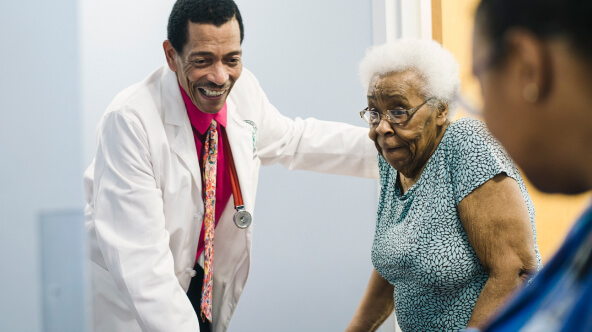Rural health clinics face daunting challenges. Technology can help.
Rural health centers serve as havens of healthcare for the communities they serve. But in these counties where the population is more spread out and resources are spread thin, the challenges of delivering care are significant – and growing.
One contributing factor: Rural hospitals across the U.S. have been closing at an alarming rate. Between 2005 and 2023, 146 hospitals in rural U.S. counties either shut down completely or stopped providing short-term, acute inpatient care.1 For rural patients who use hospital emergency departments for primary care, these closures mean losing access to “front door” healthcare services they relied on to keep themselves and their families healthy.
With the loss of these larger healthcare facilities, it’s never been more crucial to help rural health clinics remain sustainable. As healthcare providers in rural areas find themselves serving more patients with fewer resources, technology is stepping in to help. Read on to see how innovative Healthcare IT solutions are enabling rural health centers to overcome these challenges and deliver care for their communities.
Feeling the financial pinch
Rural health centers are no strangers to financial stress. Many of these centers operate on a not-for-profit model, which limits their ability to generate surplus income to reinvest in staff, infrastructure, facilities, and equipment. Furthermore, even if not mandated to do so, many rural health centers serve uninsured or underinsured patients, often offering sliding fee scales to ensure these individuals can access care. This can result in lower patient payments, further straining financial resources.
With a large proportion of rural residents relying on Medicare or Medicaid, the financial health of rural health clinics is closely tied to these government programs. Medicaid is indispensable in rural areas: as of 2020-2021, nearly one out of two children (47%) and one in five adults (18%) in rural counties are covered by Medicaid/CHIP.2 In athenahealth’s 2025 Physician Sentiment Survey, three out of five rural physicians (61%) cited Medicare and Medicaid reimbursements as a top concern.3
The right healthcare technology can help rural health centers remain resilient and fulfill their mission of care. An all-in-one EHR, practice & revenue cycle management, and patient engagement solution that streamlines claims submission and payment collection can help community health centers get reimbursed for the care they deliver. Using built-in online patient payment tools that allow patients to view their bill, make a payment, and set up a payment plan, rural health centers can realize more of the patient pay they’re owed. For rural health centers considering value-based care (VBC) models, it’s a good idea to use technology that’s designed to support these programs, so they can attest to quality measures and collect the VBC payments they qualify for.
Nearly all surveyed physicians at rural practices (94%) believe better system connectivity could improve the physician experience.
Delivering today’s care with yesterday’s technology
Maintaining and upgrading technology can be another hurdle. Many rural health centers have outdated IT systems – but not the funds to replace them. While government funding for rural health infrastructure occasionally comes through, such as the $75 million investment from the Department of Health and Human Services in 20244, it’s on each rural health center to come up with the rest of the funds and prioritize improvements that will make a difference in its own community.
Furthermore, physicians in rural areas are less satisfied with the core functionalities of the tech they do have. The 2025 Physician Sentiment Survey found that only 22% of rural physicians say it’s easy to send and receive data across different EHR systems (vs. 28% overall).5 Nearly all surveyed physicians at rural practices (94%) believe better system connectivity could improve the physician experience.6 Emerging technologies like artificial intelligence could transform care delivery, but they can also be expensive to implement. But falling behind in adopting these tools could hurt care quality and efficiency.
To overcome these challenges, rural health centers can adopt Healthcare IT solutions that integrate cutting-edge tools while simplifying workflows. AI-driven features, such as ambient documentation, dictation tools, and automated processes, can reduce the burden on clinicians and staff, and ultimately improve care delivery. And according to the 2025 Physician Sentiment Survey, many physicians are ready for these artificial intelligence capabilities.7 Whether AI bridges or widens the gaps in health equity will ultimately depend on how it’s deployed.
Coping with clinician and staff shortages
Finding healthcare workers is often a struggle for rural health centers. While 20% of Americans live in rural areas, only 10% of doctors practice there.8 In the U.S., only 4% to 5% of incoming medical students come from rural areas, and they are the ones most likely to choose to work in rural settings.9 The physician-to-patient ratio in rural areas lags far behind that of urban areas, with just 39.8 physicians per 100,000 people compared to 53.3 physicians per 100,000 people in more densely populated areas.10
This human resources shortage extends beyond clinicians to non-clinical roles like coders. Nationwide, there’s a 30% shortage in medical coders,11 leaving healthcare organizations of all sizes struggling with billing and claims. It can be difficult to find billers familiar with the nuances of complex, changing coding requirements. Without adequate coding support, rural health centers risk delays in revenue collection and even denied claims if coding is inaccurate or incomplete.
Partnering with Healthcare IT providers for workforce support can ease staffing shortages and improve operations. As one example, some Healthcare IT solutions offer medical coding services, with teams of certified coders who can handle coding tasks on behalf of the rural health center. Services like this not only take on the coding work; they also relieve the burden of identifying and hiring qualified administrative staff in rural locations where such employees may be few and far between.
Reaching rural patients who face barriers to care
Patients living in rural communities face many of the same healthcare obstacles that patients in more populated areas encounter – exacerbated by geography and the relative scarcity of services. Each rural care center or hospital that closes leaves behind a community that must now travel farther to receive care. Overall, rural patients typically travel two to three times farther to obtain healthcare than their urban counterparts.12
With rural care facilities closing or being unequipped to provide certain types of care, the situation grows more challenging. One study found that the number of rural residents traveling 30 minutes or more for medical or dental care increased by 33% between 2001 and 2017.13 That’s without factoring in patients’ individual financial circumstances, health insurance coverage or lack thereof, or access to transportation, any of which can affect or impede rural patients’ access to care. According to physicians, technology has helped mitigate the impact of social determinants of health (SDOH) such as these to some extent, but not universally. The 2025 Physician Sentiment Survey found that despite efforts to integrate SDOH into care delivery, only 43% of rural physicians say technology helps them address those factors.14
A Healthcare IT solution that offers built-in telehealth capabilities can help isolated rural patients stay in touch with their clinicians and care teams, unimpeded by distance or lack of transportation. Telehealth tools built into the EHR make it easier for clinicians to connect with the patient right in the clinical workflow, and even allow for a third party such as a family member or another care team member to join the call.
What could your rural health center accomplish with the right Healthcare IT partner?
Have you run into challenges like these at your community health center? The right Healthcare IT solution could help your organization thrive. athenaOne® for Community Health Centers is the all-in-one EHR, practice & revenue cycle management, and patient engagement solution that’s designed to help rural health centers, FQHCs, and community health centers stay sustainable and serve their communities. See what sets us apart.
More rural/underserved care resources
Continue exploring
- Rupasingha, A. and Cho, J., Feb. 18, 2025. 146 rural hospitals closed or stopped providing inpatient services from 2005 to 2023 in the United States. U.S. Department of Agriculture Economic Research Service. Retrieved May 16, 2025 from https://www.ers.usda.gov/data-products/charts-of-note/chart-detail?chartId=110927
- Osorio, A., Alker, J., and Park, E., Aug. 17, 2023. Medicaid’s Coverage Role in Small Towns and Rural Areas. Georgetown University McCourt School of Public Policy Center for Children and Families. Retrieved May 16, 2025 from https://ccf.georgetown.edu/2023/08/17/medicaids-coverage-role-in-small-towns-and-rural-areas
- 2025 Physician Sentiment Survey of 1,001 physicians nationwide, commissioned by athenahealth and fielded by Harris Poll, Jan. 2025
- Lagasse, J., Sep. 26, 2024. HHS investing $75 million in rural healthcare infrastructure. Healthcare Finance News. Retrieved May 16, 2025 from https://www.healthcarefinancenews.com/news/hhs-investing-75-million-rural-healthcare-infrastructure
- 2025 Physician Sentiment Survey
- 2025 Physician Sentiment Survey
- 2025 Physician Sentiment Survey
- Lagasse, J., op. cit.
- Henry, T.A., Jun. 6, 2024. AMA outlines 5 keys to fixing America’s rural health crisis. American Medical Association. Retrieved May 16, 2025 from https://www.ama-assn.org/delivering-care/population-care/ama-outlines-5-keys-fixing-america-s-rural-health-crisis
- National Rural Health Association, “About NRHA.” (n.d.) Retrieved May 16, 2025 from https://www.ruralhealth.us/about-us/about-rural-health-care
- Lubell, J., Apr. 19, 2023. Addressing another health care shortage: medical coders. American Medical Association. Retrieved May 16, 2025 from https://www.ama-assn.org/about/leadership/addressing-another-health-care-shortage-medical-coders
- Hearn, M., Pinto, C., and Moss, J.L., Jul. 25, 2024. Evaluating the Connection Between Rural Travel Time and Health: A Cross-Sectional Analysis of Older Adults Living in the Northeast United States. Journal of Primary Care & Community Health. Jul. 2024. Retrieved May 16, 2025 from https://pmc.ncbi.nlm.nih.gov/articles/PMC11273699/
- Kellet, A., Aug.25, 2023. Travel time for health care has increased for both rural and urban Americans. Vital Record: News from Texas A&M Health. Retrieved May 16, 2025 from https://vitalrecord.tamu.edu/travel-time-for-health-care-has-increased-for-both-rural-and-urban-americans
- 2025 Physician Sentiment Survey












